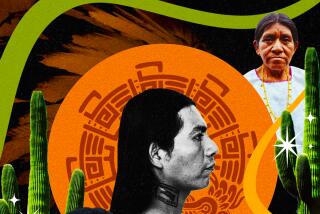Woman Brings Tribe’s Dead Language to Life
- Share via
BOSTON — It started with a dream.
Jessie Little Doe Fermino saw Indian ancestors she didn’t recognize, speaking a language she knew but couldn’t understand.
It was Wopanaak--the Wampanoag language that hadn’t been written or spoken for almost 150 years.
“I got these feelings in me of wanting to know what Wopanaak was, how it was used,” Fermino says.
Seven years after she had that dream, the 36-year-old former social worker is working full-time to teach fellow tribal members what she learned.
“I started looking around for documentation, thinking there was none, and instead I found a huge body of native written documents,” says Fermino, who earned a masters in linguistics at the Massachusetts Institute of Technology.
The Wampanoags’ legacy includes a letter to Massachusetts’ colonial legislature, written June 11, 1752, pleading with lawmakers to keep white settlers from taking their land.
The first Bible printed in the New World was a Wopanaak translation of the King James Bible, printed at Harvard in 1663 by John Eliot. The Wopanaak language was translated into phonetic English by missionaries such as Eliot, who believed it their duty to convert the Indians to Christianity. The different spellings of the tribal name and the language are a result of trying to write down the distinct Indian vowel sounds using the highly irregular English spellings of the 1600s.
Wopanaak reflects the Wampanoags’ own beliefs about their relationships with one another and the world around them.
“In a lot of ways, it’s the essence of being part of a circle or a tribe,” Fermino explains. “You place someone else first, not always yourself. . . . You are responsible to your whole people, and that’s reflected in the language.”
For example, in statements addressing other people, the speaker comes last, not first. So the word order of “I see you” is changed to “You see I.” In Wopanaak, that’s kunaush [pronounced kuh nah’sh].
Kinship is also distinctively expressed. The word for a sister or a father or a mother cannot stand alone; it requires a possessive attachment indicating relationship to another person, such as “my sister” or “your father” or “her mother.”
“The point,” says Fermino, “is that for all kinship terms every human being is one individual who is part of a larger circle, and that relationship to the rest of the circle is expressed through the language.”
The stem for “mother” is -8hkas, pronounced “oo’ kas.” The “8” is not a typo: It’s a letter for the “oo” sound in the Wopanaak language. But that stem is not a word on its own. It needs to belong to someone. To say “my mother,” for example, it would be n8hkas (noo’ kas).
Fermino’s classes are restricted to Wampanoags. They are held in Mashpee, where she lives, and in Aquinnah, on Martha’s Vineyard.
Her students want to learn enough Wopanaak to converse, write poetry, read the writings of their ancestors and sing and pray in their own language.
“As a tribal people, we know we always had our own language,” says Tobias J. Vanderhoop, 26, of Aquinnah, a member of the Gay Head Aquinnah Wampanoag tribal council. “For a lot of us there has always been a wish we could speak our own language.”
To hear the language evokes strong emotion, Vanderhoop says.
“Chills just overtake you,” he says. “Not only are you hearing your language, but you can understand it, and you know your ancestors can understand it. So it is a very powerful thing.”
The Wampanoags, whose name means “People of the Light,” are one of a number of American Indian tribes who are taking steps to revive or reclaim their languages, spurred by the dropping numbers of fluent speakers.
Scholars believe some 300 native languages were spoken in North America when European colonization began. That has dwindled to about 155 languages today.
Wampanoag Tribe of Gay Head Aquinnah: https://www.wampanoagtribe.net/
Plimoth Plantation museum library: https://www.plimoth.org/library/wampanoag/wampnow.htm
More to Read
Sign up for Essential California
The most important California stories and recommendations in your inbox every morning.
You may occasionally receive promotional content from the Los Angeles Times.












